The American pitbull terrier is a medium-sized terrier dog originally from England. Pitbulls are also commonly referred to as pitbull terriers, pits, and APBTs.
These dogs have muscular builds, grow up to 21 inches, and weigh between 30 and 60 pounds. The breed’s average life expectancy is 12 to 16 years.
Pitbulls get along well with children and are known for their loyal, affectionate, and friendly nature. However, these dogs have a high prey drive and need a lot of training to curb their aggression toward other dogs.
Pitbulls typically cost $800 to $2,500.
TABLE OF CONTENTS
Pitbull Dog Characteristics & Overview
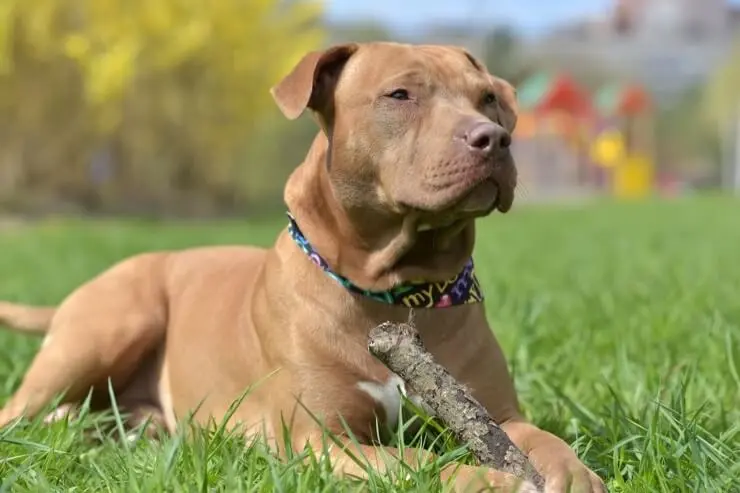
From Adobe Stock
| Common names: | American pitbull terrier, American pit bull terrier, APBT, pit, pitbull terrier |
| Origin: | England, United States |
| Breed group: | Terrier dog |
| Size: | Medium |
| Height: | Up to 21 inches |
| Weight: | 30–60 pounds |
| Colors: | All colors and patterns apart from merle |
| Coat: | Smooth, glossy short coat |
| Life expectancy: | 12–16 years |
| Temperament: | Affectionate, friendly, loyal, eager to please, courageous |
| Shedding: | Minimal shedding |
| Barking tendency: | Low to moderate |
| Cost: | $800–$2,500 |
Origin & Purpose
The American pitbull terrier is one of several breeds categorized under the generic term pitbull. Other breeds include the bull terrier, American Staffordshire terrier, and the Staffordshire bull terrier.
The pitbull originated in 19th-century England. Bulldogs and terriers were bred together to create dogs that excelled in blood sports like bull-baiting and dogfighting. Immigrants from the British Isles later introduced these dogs to the United States, where they were further selectively bred to become the medium-sized, affectionate American pitbull terriers known and loved today.
The American pitbull terrier was recognized by the United Kennel Club (UKC) in 1898, but hasn’t yet been acknowledged by the American Kennel Club (AKC). The breed is banned or restricted in several countries, cities, and towns because of its history of dogfighting and association with dog attacks and criminal activity.
Lifespan
Pitbull dogs have an average life expectancy of 12 to 16 years. Regular exercise, a nutritious diet, and regular vet checkups help pitbulls live long and healthy lives.
Health issues like congenital cardiac disease and degenerative myelopathy can shorten these dogs’ lifespans.
Pitbull Appearance
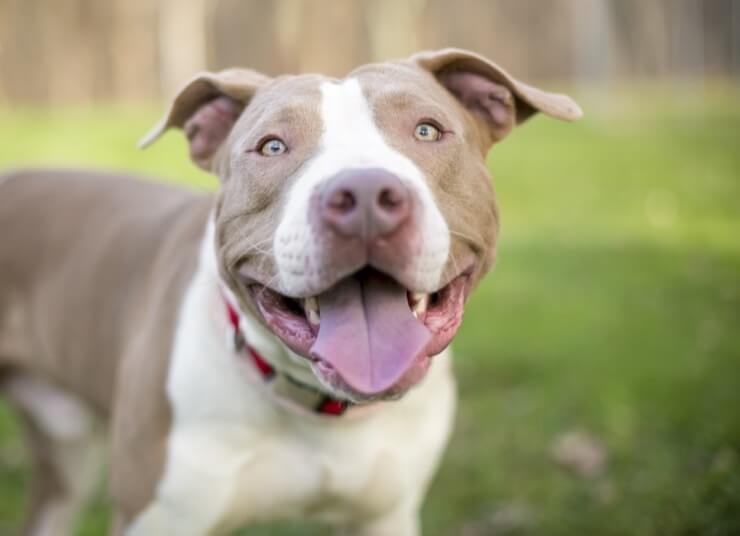
From Adobe Stock
American pitbull terriers are medium-sized, muscular dogs with broad heads, wide muzzles, and round eyes. Pitbulls have smooth, short coats and come in various colors and patterns.
Height and Weight
Pitbulls are considered medium-sized dogs, with a height at the withers of 17–21 inches, and a weight of 30–60 pounds. Male American pitbull terriers weigh 35–60 pounds and reach 18–21 inches tall, while females weigh 30–50 pounds and reach 17–20 inches tall.
Aside from sex, other factors that can affect a dog’s size include bloodline, daily calorie intake, and activity level.
A three-month-old pitbull dog puppy weighs 10–20 pounds. The breed reaches its full adult size within 12 months.
Colors
Pitbulls are typically brown, black, or tan. However, these dogs can have a range of colors and markings, with merle being the only color not recognized by the UKC. Uncommon colors include solid white, brindle, and black pitbulls, while blue-nosed pitbulls are the rarest.
Coat
Pitbulls have short single coats that shed minimally throughout the year. The coat is smooth, glossy, and easy to groom because it isn’t prone to tangles or mats.
Personality and Temperament
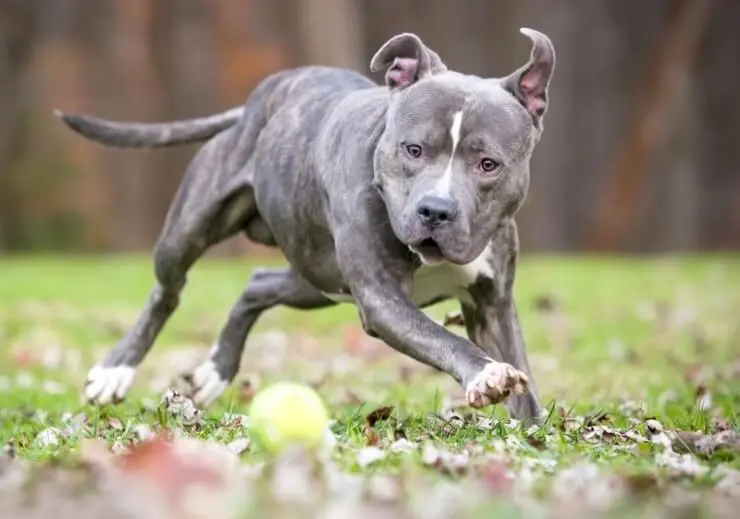
From Adobe Stock
Pitbulls are affectionate, enthusiastic, and loyal dogs that are known for their goofy antics and confidence. They are gentle with children.
These dogs are easy to train because of their intelligence and eagerness to please. However, pitbulls often exhibit dog aggression without proper socialization and training, so they’re best suited to experienced owners. They also have a high prey drive and shouldn’t be kept with small pets like rabbits.
American pitbull terriers are often labeled dangerous dogs. However, with appropriate training and care, pitbulls are rarely aggressive toward people. According to the American Temperament Test Society (ATTS), these dogs have a temperament passing rate of 87.4%, which is higher than breeds like the border collie (82.4%), German shepherd dog (85.3%), and golden retriever (85.6%).
Barking
American pitbull terriers are quiet dogs that only bark when they want to gain their owners’ attention. However, pitbulls that are left alone for long periods are likely to engage in excessive barking.
Pitbull Care
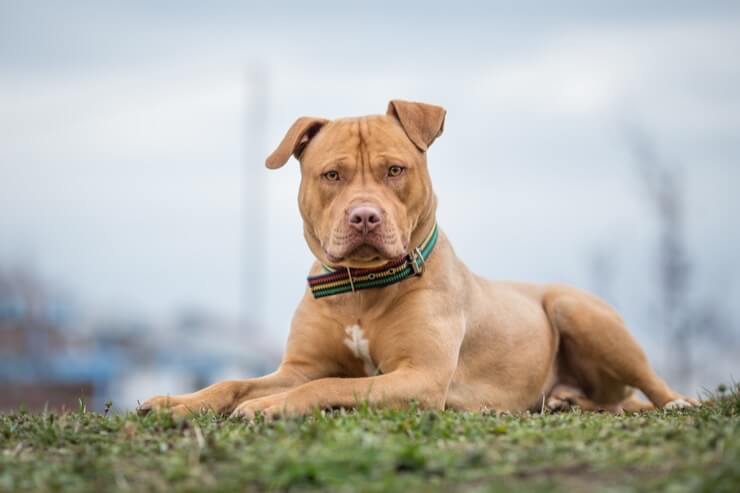
From Adobe Stock
Pitbulls are moderately difficult to care for. While these dogs are easy to train and have a low-maintenance coat, they need plenty of attention, training, and socialization throughout their lives to reduce their prey drive and aggressiveness toward other dogs.
Food Needs
American pitbull terriers should be fed protein-rich kibble made for medium-sized dogs. Feed pitbulls 2 to 3 cups of kibble per day, split into two separate meals, and offer food at the same times each day.
Puppies should be fed 2 to 5 cups of puppy-formulated food daily, depending on size, energy level, sex, and metabolism.
Adult food must contain at least 18% protein and 5% fat, while puppies require at least 22% of protein and 8% fat in their food to support their fast growth. Provide fresh water daily and clean the food bowl on a weekly basis.
Grooming Needs
The American pitbull terrier has a smooth, short single coat that sheds minimally all year round. The dog’s coat should be brushed weekly to remove dead hair, dislodge trapped dirt, and distribute natural oils.
Nails must be kept well-trimmed, and owners should also check the ears and skin regularly for signs of infection.
Bathe pitbulls monthly to keep their coats glossy and healthy, and brush their teeth with dog-friendly toothpaste three to four times per week.
Exercise Needs
Pitbulls need at least 60 minutes of exercise per day, split into two separate walks, to stay healthy. These dogs have agile and muscular bodies, making them suitable for physical activities such as running, agility, and weight pulling.
Pitbull dogs are adaptable and can happily live in an apartment as long as they’re given enough exercise, attention, and mental stimulation throughout the day. However, they have high prey drives and should always be supervised around other animals.
Some countries, cities, and territories have breed-specific laws in place that require pitbulls to wear muzzles and be leashed at all times in public. Check local laws as restrictions vary.
Mental Needs
Pitbulls benefit from at least 60 minutes of mental stimulation per day in the form of training, scent games, puzzle toys, or interactive games like fetch. Mental stimulation helps dogs stay mentally fit and happy while strengthening family bonds.
Provide them with durable chew toys.
Common Health Concerns
Pitbulls are prone to several health conditions, including congenital cardiac disease, hip dysplasia, and degenerative myelopathy. Regular vet checkups and keeping your dog at a healthy weight help prevent health issues.
- Congenital cardiac disease: A malformation of the heart that causes shortness of breath, coughing, exercise intolerance, and fatigue. Treatment depends on the type of defect and severity.
- Hip dysplasia: An abnormal formation of the hip joint that causes pain and mobility issues. Treatment involves surgery, physical therapy, and medication.
- Degenerative myelopathy: A degeneration of the spinal cord that eventually leads to paralysis. Initial symptoms include hind leg weakness and incontinence. There is no known treatment for this disease.
- Patella luxation: A condition when the kneecap moves out of place and dislocates. The main symptom is a “hopping” lameness. Treatment depends on severity, but typically involves surgery.
- Thyroid disease: A disease when the thyroid doesn’t function properly and affects the dog’s metabolism. Treatment involves thyroid replacement hormone medication.
- Allergies: Issues such as skin and food sensitivities that are particularly common in pitbulls.
- Mange: A condition with mites that cause itchiness, pain, thinning hair, and bald patches. Mange is treatable with medication.
- Cataracts: Abnormal cloudiness of the eye lens, leading to vision problems. Cataracts can be removed with surgery.
Only buy pitbull puppies from breeders that are willing to show you the parents’ health screenings. Breeders should also let you visit the puppies and see them interact with their mothers.
Training
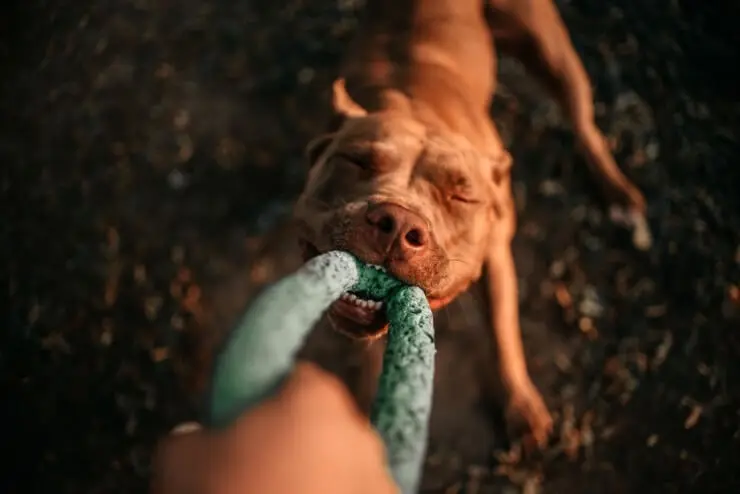
From Adobe Stock
Pitbull dogs are easy to train because they’re smart and love pleasing their owners. However, socialization and training from a young age are essential to curb the breed’s high prey drive and prevent aggression toward other dogs.
Socialization should begin as early as eight weeks. Expose the pitbull to a range of experiences, people, and animals in a positive manner. Puppies should also be taught vital obedience commands, such as leave it, sit, stay, and come, and how to behave around other dogs and small animals.
Muzzle training and leash training are particularly important for pitbulls.
Be firm and consistent with training, and always use positive reinforcement. Negative reinforcement like punishment and fear-based training can cause stress and worsen the breed’s aggressive tendencies.
Because pitbulls are prone to dog aggression, owners should be well informed on how to break up a dog fight.
Pitbull Dog Price
The pitbull is a moderately expensive breed, with the exact cost depending on bloodline, age, appearance, and whether the dog is from a rescue shelter or breeder. Health issues and training classes can increase the total cost of pitbull ownership.
How Much is a Pitbull?
Pitbulls typically cost $800 to $2,500, though puppies from champion bloodlines can cost more. Rare coat colors, like red, blue, and solid white, also increase the price.
Rescuing an adult from a shelter, which costs $100 to $350 on average, is much cheaper than buying a puppy from a breeder. The breed is common in rescue shelters and there are several pitbull-specific rescue organizations in the United States.
How Much Does it Cost to Own a Pitbull Dog?
Owning a pitbull dog costs between $100 to $170 per month, which includes expenses such as food, treats, grooming supplies, and vet visits. Expect to pay more in the first year because of initial costs such as puppy vaccinations, training tools, and neutering.
Is a Pitbull Right for You?
Pitbulls are affectionate, intelligent, and loyal dogs that make ideal family companions and keep their owners entertained with their clownish behavior. However, these dogs aren’t suitable for all families and lifestyles because of the breed’s strength, prey drive, and proneness to dog aggression.
Who Should Get a Pitbull Dog?
American pitbull terriers are ideal for experienced dog owners that can spend plenty of time on their training and care. Pitbulls are well-suited to families with children. While this breed does best in households with backyards, it can happily live in apartments if exercised regularly.
The best owners for pitbulls are people who use positive reinforcement and know how to safely deal with dog aggression.
Who Should Not Get a Pitbull Dog?
First-time owners should avoid pitbulls because these dogs are strong and difficult to control without experience. Pitbulls shouldn’t be kept in multi-pet households and also aren’t suitable for people who lead sedentary lifestyles.
These dogs aren’t ideal for those that enjoy traveling because several local areas, cities, and countries have banned or put restrictions on pitbull ownership. Always check local laws before considering this breed.
Pitbull Mixed Breeds
If you’re interested in an American pitbull terrier, but aren’t thrilled about the health and ethical concerns surrounding the purebred pitbull, consider these crossbreed dogs:









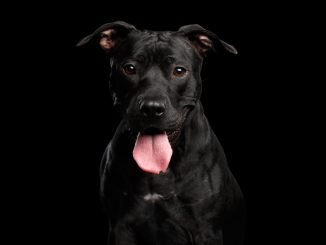

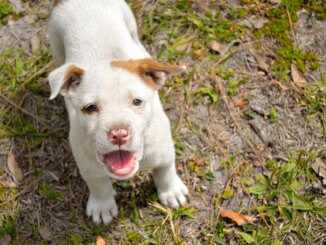

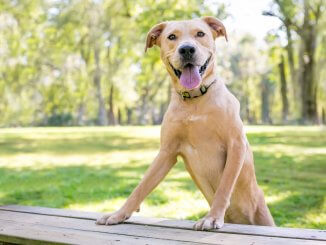

I got my First pitty for my second birthday. I have been owned by a pitty since then. This year makes 62years that I have had a pitty in my life.
Getting a pit bull was the best choice I ever made when looking for a companion. I say she’s my best friend, and I mean it. It’s very important to keep socializing them with dogs throughout their life. You’ll be surprised how quickly they can regress, especially how mine did during the winter and pandemic. We have to relearn friendly skills and ignoring barking yard dogs. Her weakness is woman and children. Especially children. Their little fingers are full of flavor from finger food and she loves to lick. And they’re shorter, so she can easily reach the face for a sneaky mouth lick. She plays differently with kids than me, and it wasn’t trained. It’s like she knows she has to be gentle, and she lets them take the lead, looking back at them for direction or just standing at their side, watching what their doing.
They are very loyal to humans all together. Absolute people pleasers, and once you train them that getting praised and positive attention are the best ‘treat’ they can earn, they’ll be the best behaved, good listening dog you’ll own. They really go crazy over ‘good girl/boy’. My girl can’t help but wiggle her tail and give a pitty smirk when I baby talk her.
They do have high energy but can be trained to ‘hold it’ until the proper place they can unleash the beast at. They make for quiet apartment dogs, as long as you can give them outdoor activities. Only complaint about noise is they can snore louder than your husband, but you don’t want to kick them out of the room for it.
I have been a proud mom, grandma and aunt to my fur babies . Raised my son with his first companion, Rocky. Rocky had babies, which we kept three off. Rocky passed away in my lap from Cancer. We still have some and mom, although I was blessed with a new pit-baby Jake,he doesn’t play well with the other two. We keep them separated but they are all loved equally with our one common denominator my son.